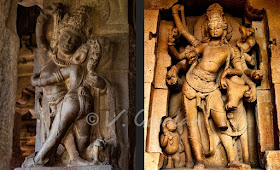Pullamangai temple is located on the outskirts of Pashupathikoil, between Tanjavoor and Kumbakonam of Tamil Nadu. This temple is very deceptive to look at from outside but once you are inside this temple, you will discover its extraordinary grandeur! It was built during the early years of Chola King Parantaka Choladeva-1. Hence this temple existed with active worship during the early 7th century CE.

People refer to this temple by various names - Thiruvalanthurai Mahadevar Temple, Sri Brahmapurisvara Temple, or Tiruppullamangai Temple!


The presiding deity of Pullamangai is Brahmapuriswara - a form of Lord Shiva. This temple is often cited as Brahma Temple because of the sculptures on the exterior walls include a number of beautiful images of Brahma.

There are a number of extraordinary sculptures in this temple! Of the hundreds of sculptures seen in this temple the most adorable ones are Shiva's Ganas! These Ganas are depicted in different happy moods and dancing poses!


The Lingobhava murti seen here are very similar to the ones seen in Big temple of Tanjavoor and Gangaikonda Chozhapuram.















